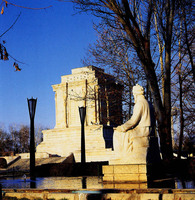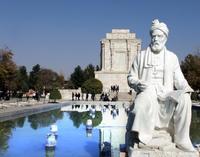Firdawsi
Firdawsi, Abu al-Qasim Mansur ibn Hasan (940/941-1020/1025), a philosopher and poet born into a feudal family in the village of Bazh, in the vicinity of the city of Tus. He took up the composition of the Shahnama (Book of Kings) in his forties, versifying work in prose bearing the same title. He completed the first version in 994 to which he later supplemented further stories. Having visited the court of the Ghaznavid Sultan Mahmud ibn Nasir al-Din Sabuktakin (Sabuktegin) in 1004, he was intent on prepariong another versian of the Shahnama and dedicate it to the sultan. However, the sultan who awarded poets in abundance mistreated him. Having incurred the sultan’s wrath, he fled from Ghaznin to Herat and then to Mazandaran. He returned to Khurasan late in life and died in his hometown in 1020 or 1025. His family were landowners in Bazh, a village in the district of Tus, where they mainly spent their lives. In his Shahnama, Firdawsi has included materials that shed light on his life, reflecting that he married once in his youth and had fathered a son and a daughter. His son passed away at the age of 37 when the poet was 65 years of age. Thus, his son had been born when he was 28 years of age and his daughter was younger than his son. Firdawsi collected the Shahnama at the behest of Abu Mansur Muhammad ibn ‘Abd al-Razzaq who was of a man of noble descent appointed governor of Tus by Abu ‘Ali Ahmad ibn Muhammad Chaghani around 946 or a few years earlier. It was in that year that Abu ‘Ali rose against the Samanid King. Abu Mansur took the side of Abu ‘Ali and when the latter led a campaign to Marw, the former chose him as his army general in Kurasan. Abu Mansur, a Samanid agen, incurred defeat and led a clandestine life for a while in Azerbaijan. Finally, he attached himself to the court of the Samanid King and was appointed the army general in Khurasan by the Samanid ‘Abd al-Malik ibn Nuh, but he was dismissed in January 961 and was replaced by Alptakin (Alptegin) who was dismissed in 961 and was succeeded by Abu Mansur. Then, intent on forming a coalition with the Daylamid Rukn al-Dawla Hasan and was summoned to Gurgan. Having obtained the intelligence, Wushmgir ibn Ziyar commissioned a physician, Yuhanna (John), to poison him which he did in January 962. Having failed to find anybody deserving the dedication of his immortal and unrivalled magnum opus, he, at the age of 65 or 66, dedicated it to the Ghaznavid Mahmud, the most powerful king at the time, in 1003 or 1004, when he was in dire financial straits consequent to the loss of his inherited farms in the cause of composition of the Persian national epic. The propaganda agents of Sultan Mahmud of Turkic descent tried to take advantage of the popularity of the noble Dehqan of Tus, urging him to set his hopes on Sultan Mahmud’s tremendous patronage paid to poets to attain enduring fame by dedicating his Shahnama to him. Thus, Firdawsi dedicated the second version of Shahnama, to which he had added further stories in praise of Mahmud in 1009 or 1010. Having completed the version, he dedicated it to Mahmud in Ghaznin. He unexpectedly incurred the sultan’s disfavour as he was rewarded by one dirham, rather than one dinar, against each couplet. Enraged by such mistreatment, Firdawsi paid the reward to a beer seller and a man in charge of a public bath. It is reported that the difference between the poet and the sultan mainly stemmed from religious, political, and ethnic issues. The poet had attacked Turks many a time in his Shahnama and Mahmud was of Turkic descent. Further, Firdawsi was a sympathized with the Shi’i, but Sultan Mahmud bore animosity against the Shi’i, the Mu’tazilis, and those of a philosophical turn of mind. Threatened by excommunication, apostasy charges, and being trampled by elephants, he fled from Ghaznin and sought refuge in the home of Isma’il Warraq, a noble man and the father of Azraqi, the poet, in Herat where he stayed for six months until those dispatched by Sultan Mahmud to apprehend him returned from Tus. Finding a safe haven in Tus, he departed for the court of Sipahbud Shahriyar, a Shi’i ruler from the Bawandid dynasty. Addressing the ruler by saying that mention is made of his ancestors throughout the Shahnama, he was intent on dedicating it to the ruler, though the latter declined for his fear of Sultan Mahmud. Then, Firdawsi departed Tabaristan for Khurasan and desperately devoted his last years to final revision of Shahnama and adding verses to it. He died in his hometown in 1020 and was laid to rest in his own garden. It is reported that his main source in the versification of the Shahnama was a prose rendering of the Pahlavi Khwadaynama whose original version closed with the death of Khusraw Parviz. Khwadaynama had been compiled by an erudite Dehqan in the late Sassanid era, probably under Yazdgird III. It is also reported that the book was compiled by a number of Zoroastrian scholars at the behest of Abu Mansur ibn ‘Abd al-Razzaq, the governor of Tus. Khwadaynama is the major source on pre-Islamic Persia used by historians writing in Arabic and Persian. The title of the Pahlavi source was translated into Arabic and Persian as Siyar Muluk (al-‘Ajam) and Shahnama respectively. Ruzbih, well-known as Ibn al-Muqaffa’, was one of the translators who translated the Khwadaynama into Arabic. It is to be noted that the original Pahlavi Khwadaynama and Ibn Muqaffa’s translation are not extant and his translation was the first rendering directly based on the original Pahlavi work. The number of couplets of Firdawsi’s Shahnama runs to 60,000, a thousand of which had been versified by Daqiqi. Firdawsi began his education at an early age, developing an interest in reading stories, particularly the history and mythology of pre-Islamic Persia, later encouraging him to compose the Shahnama. As reflected in the Shahnama, he searched for the book for long. It is reported that he spent 25, 30, or 35 years of his life on its composition, though it is certain that he neither followed the present order of the stories in his composition nor did he incessantly preoccupied himself with it. It may be stated that he devoted 30 years of his life to its composition. It is also reported that after some years, Sultan Mahmud was reminded of Firdawsi. Having regretted his mistreatment of the poet and intent on offering him solace, he ordered that abundant gifts of tremendous value be sent to him to Tus, but as reported by biographers, the poet’s funeral procession coincided with the arrival of the gifts at the gates of Tus. The Shahnama is not only the greatest and the richest collection of poetry from the Samanid and Ghaznavid times, but it is the most significant proof of the exaltedness of Persian language and the most evident proof of the glory and prosperity of ancient Persian culture and civilization and the greatest treasure of Persian lexicon and literature. Firdawsi is the poet and sage par excellence and the most distinguished epic poet of the world. He embarked upon composing the Shahnama in 980 aware of the supervision of spies from Baghdad and Ghazna. He knew that they attend to his analysis of the political forces of Baghdad and their Turkic elements in Persia. Shahnama treats of the mythological, heroic, and historical eras. Based on ancient sources, Firdawsi constructs an exalted palace of Persian eloquence untouched by ‘gales and rain’ or the passage of time. Encountering the stories of the Shahnama and further mythological narratives, one may not be content with the fictional forms, since the mythological idiom is imbued with symbols and inattentiveness towards the allegorical significance of mythology reduces it to ordinary fiction. Shanama treats of the conflicts between the good and the evil and the heroes and warrior are engaged in this everlasting conflict. The war waged by Kava and the tyrannical Zahhak, the vengeance sought by Manuchihr on Salm and Tur, and the murder of Siyavush consequent to Sudaba’s stratagems, among other stories, reflect such conflict. In the Shahnama, Firdawsi defends the good against the evil and tyranny at all times. Persia, the land of the noble, incurs at all times the rath of her neighbors, jeopardizing her by afflictions of a diverse nature; as a consequence, her glory and beauty is endangered by different afflictions, urging her heroes to display by their profound human values and sacrifice their lives. Imagery and imaginativeness are so vigorous and harmonious in the Shahnama that Firdawsi’s depictions of nature, e.g. those of sunrise and sunset, day, and night reflect their epic nature and the delicacies of the sage of Tus has led to the harmony and nature of the most minute elements against the totality of the stories. Musicality is regarded as one of the most significant elements in Firdawsi’s poetry. The epic musicality of the Shahnama is multiplied by its mutaqarib meter in which long syllables are fewer than short ones. Further, employment of proper meters, vigorous rhymes, concealed and apparent consonance (assonance and alliteration), puns of diverse nature, and other figures of speech lead to tremendous musicality. Skilful hyperboles, similes, imagery, and depiction of nature and life are further significant features of his poetry. The Shahnama in prose was the earliest of independent Persian works. Since it was compiled at the behest of Abu Mansur Tusi, this history of ancient Persia is well-known as the Abu Mansurid Shahnama. Only its introduction, running to approximately 15 pages, has been incorporated in some manuscripts of the Shahnama. Further, Abu al-Mu’ayyad Balkhi’s Shahnama, in prose, predated the Abu Mansurid one, though the former is not available today. It was in the tenth century that Daqiqi embarked upon versification of the national tales of Persia. He was a Zoroastrian who took his poetical career early in life, composing eulogies on some Chaghanid and Samanid rulers who awarded him rewards of tremendous value. Daqiqi began the versification of the Abu Mansurid Shahnama at the behest of the Samanid Nuh ibn Mansur, but lost his life in 977 or 979, barely composing more than a thousand couplets. His fellow citizen, Firdawsi, resumed the task later. Thus, Daqiqi’s Shahnama may be regarded a major source of Firdawsi.
Hamasasara’i dar Iran (183-286); Tarikh-i Adabiyyat dar Iran (1/ 458-521); Tarikh-i Nazm va Nasr (39-41).


 In association with The Iran Heritage Foundation © All rights reserved 2024. Jane Lewisohn | Website by
In association with The Iran Heritage Foundation © All rights reserved 2024. Jane Lewisohn | Website by